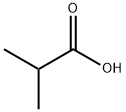A4993912
Isobutyraldehyde , 98% , 78-84-2
Synonym(s):
2-Methylpropanal;2-Methylpropionaldehyde;Isobutanal;Isobutyraldehyde
CAS NO.:78-84-2
Empirical Formula: C4H8O
Molecular Weight: 72.11
MDL number: MFCD00006980
EINECS: 201-149-6
Update time: 2022-07-08
PRODUCT Properties
| Melting point: | -65 °C (lit.) |
| Boiling point: | 63 °C (lit.) |
| Density | 0.79 g/mL at 25 °C (lit.) |
| vapor density | 2.5 (vs air) |
| vapor pressure | 66 mm Hg ( 4.4 °C) |
| refractive index | n |
| FEMA | 2220 | ISOBUTYRALDEHYDE |
| Flash point: | −40 °F |
| storage temp. | Store below +30°C. |
| solubility | water: soluble11g/100mL at 20°C(lit.) |
| form | Liquid |
| color | Clear |
| Odor | Pungent. |
| explosive limit | 1.6-11.0%(V) |
| Odor Threshold | 0.00035ppm |
| Odor Type | aldehydic |
| biological source | synthetic |
| Water Solubility | 75 g/L (20 ºC) |
| Sensitive | Air Sensitive |
| JECFA Number | 252 |
| Merck | 14,5154 |
| BRN | 605330 |
| Stability: | Stable. Refrigerate. Highly flammable. Incompatible with strong oxidizing agents, strong bases, strong acids, strong reducing agents. |
| LogP | 0.77 at 25℃ |
| CAS DataBase Reference | 78-84-2(CAS DataBase Reference) |
| NIST Chemistry Reference | Propanal, 2-methyl-(78-84-2) |
| EPA Substance Registry System | Isobutyraldehyde (78-84-2) |
Description and Uses
Isobutyraldehyde has a characteristic odor. Synthesized via oxidation of isobutyl alcohol with potassium dichromate and concentrated sulfuric acid.
Isobutyraldehyde is used as an intermediate in the preparation of isobutanol, methacrolein, hydroxypivaldehyde and neopentyl glycol. It is actively involved in the Cannizaro reaction. It is also used as an intermediate to prepare pharmaceuticals, agrochemicals, vitamins, antioxidants, rubber accelerators, textile auxiliaries, perfumery and flavors.
Safety
| Symbol(GHS) |   GHS02,GHS07 |
| Signal word | Danger |
| Hazard statements | H225-H319 |
| Precautionary statements | P210-P233-P240-P241-P242-P305+P351+P338 |
| Hazard Codes | F,Xn,Xi |
| Risk Statements | 11-22-36 |
| Safety Statements | 16-36/37-9-33-29-26 |
| RIDADR | UN 2045 3/PG 2 |
| WGK Germany | 1 |
| RTECS | NQ4025000 |
| F | 9-13-23 |
| Autoignition Temperature | 384 °F |
| TSCA | Yes |
| HS Code | 2912 19 00 |
| HazardClass | 3 |
| PackingGroup | II |
| Hazardous Substances Data | 78-84-2(Hazardous Substances Data) |
| Toxicity | LD50 orally in rats: 3.7 g/kg (Smyth) |



